Reading Statistics and Facts You Should Know in 2025
reviewed by Laila A. Lico
Updated on September 16, 2025
How good is your kid at reading? It’s hard to determine without some objective criteria and valid numbers at hand. To assist you here, check out the most recent reading statistics from 2018 to 2025 worldwide, on the national US level, and by state. At the end of this article, you’ll find the top 10 most interesting facts about reading to consider while choosing how to improve your kid’s reading skills.
Key statistics about reading
- The global literacy level is around 85%, with the majority of countries reaching 95% in literacy level and over 5 hours of average reading time per week.
- In the US, the literacy rate is around 80%, but NAEC defines the “literacy” term more rigidly than the UNESCO standard definition.
- In the US states, reading statistics for students are around the average 214.16 literacy rate.
- 17 books per week. That’s how many people read books in the United States per year.
- Tutoring is among the most effective ways to improve stats on reading, and Brighterly tutors can help your kid with that.
Reading statistics worldwide
The current reading rate is around 86% worldwide, based on the last detailed reading stats fact sheet from the UNESCO Institute for Statistics. This data includes respondents of all age groups worldwide and is based on population censuses and household surveys.
For youth aged 15-24 years old, the literacy rate is even higher, reaching 91%.
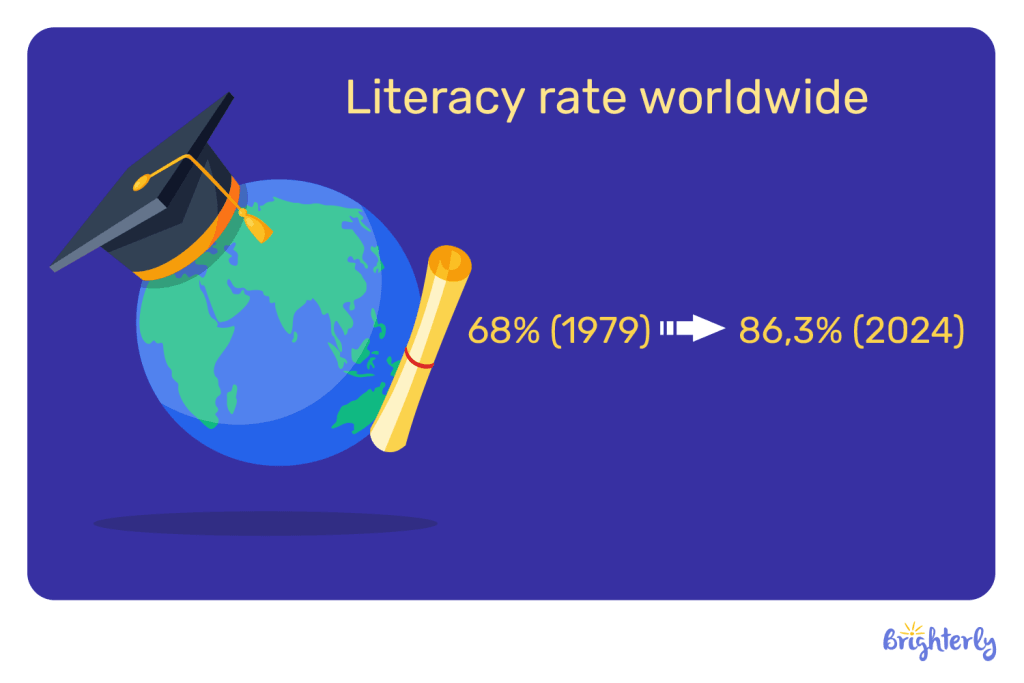
As for the statistics on reading and success, the most reading nations live in Latin America, Eastern Europe, and Asia, while the least reading ones are located in Central Africa.
Literacy rate % |
Countries |
| 90% – 100% | Ukraine, Mexico, Spain, Brazil, China, Egypt |
| 70 – 89% | India, Tanzania, Myanmar, Angola, Pakistan |
| 69% and less | Mauritania, Mali, Niger, Iraq, Afghanistan |
Is it true that 40% of school age children can’t read? Mostly not, as the literacy level is higher than 50%, so it’s not true for most countries in the world.
The most literate countries also tend to maintain gender parity when it comes to access to literacy among youth. But some countries have certain gender favors.
Men-favored countries |
Women-favored countries |
| -Tanzania | – Algeria |
| -Democratic Republic of Congo | – Mali |
| -Nepal | – Cambodia |
| -Afghanistan | – Yemen |
| -Pakistan and 17 more | – Zimbabwe and 5 more |
Source: Our World in Data 2025
Note: Based on the UNESCO definition, literacy rate is the % of the population that are able to write and read a short, simple statement about everyday life and conduct basic arithmetic operations.
Another interesting book reading statistics from the NOP World CultureScore Index shows that India is a leader in the average weekly reading time, with Thailand coming second, and China coming third.
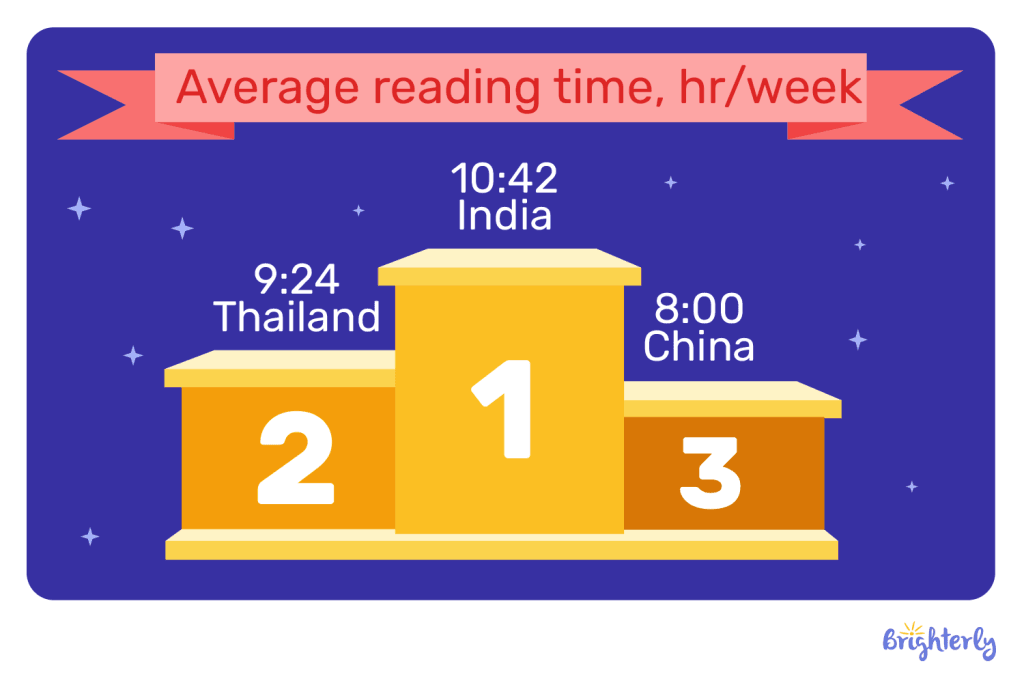
In countries like the USA, Germany, and the UK, the reading time is below 6 hours, which shows that the scrolling culture makes it harder for people to pay enough attention to books and enjoy them.
What are statistics in reading in the US?
Based on the National Center for Education Statistics (NCES) 2019 data, the average literacy rate in the US is 79%, meaning that 43 million US adults possess low literacy skills.
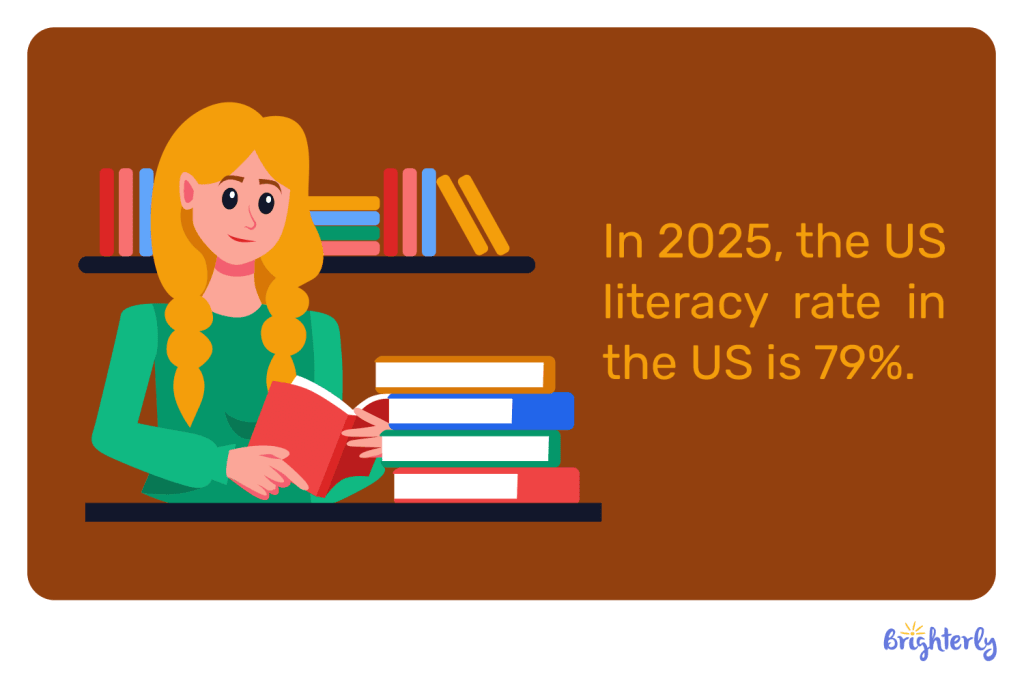
How the US reading statistics for children changed between 2022 and 2025
- 2022: After the pandemic, the reading test results showed that children lost over 20% of their English language skills.
- 2023: Students recovered around one quarter of their 2022 reading loss.
- 2024: NAEP score results showed that the reading test results were 2 points lower than in 2022.
- 2025: Based on our forecast regarding the Standardized Testing Statistics 2025, the current trend is likely to stabilize at the pre-pandemic 2019 level.
Other important reading statistics in America
- In the US, 130 million people (around 54% of the adult population) lack literacy proficiency, meaning they read below 6th grade level (Literacy Gap Map data).
- The average reading time in the US, similar to Venezuela, Canada, Mexico, and Brazil, is not over 6:30 hours per week.
- Among the low-skilled adults, White (35%) and Hispanic (34%) races/ethnicities are represented almost equally. Black people are around 23% of this population (NCES).
Note: In the US, the NCES defines literacy rate as the ability to perform compare-and-contrast, paraphrasing, and other low-level text interferences on the 2+ level in the Program for the International Assessment of Adult Competencies (PIAAC).
How to improve your reading proficiency with Brighterly reading tutors?
Hiring a private tutor is the right thing to deal with these studies on reading. It’s a person who understands how to teach reading so it feels enjoyable after class can make the situation better for your kid.
Tutors from the Brighterly reading and math tutoring platform are trained to help kids get better grades with joy. The lesson prices are affordable for low income families, and each minute spent on 1:1 sessions with the private tutor translates into pure love and joy to read books in free time.
What are the reading statistics by state?
The average literacy score in the United States by 2025 is 214.16, with the US states ranging from 201 to 222. Based on the most recent research, New Mexico and Alaska demonstrate the lowest literacy rates, while Massachusetts, Wyoming, and New Jersey are at the top of the list.
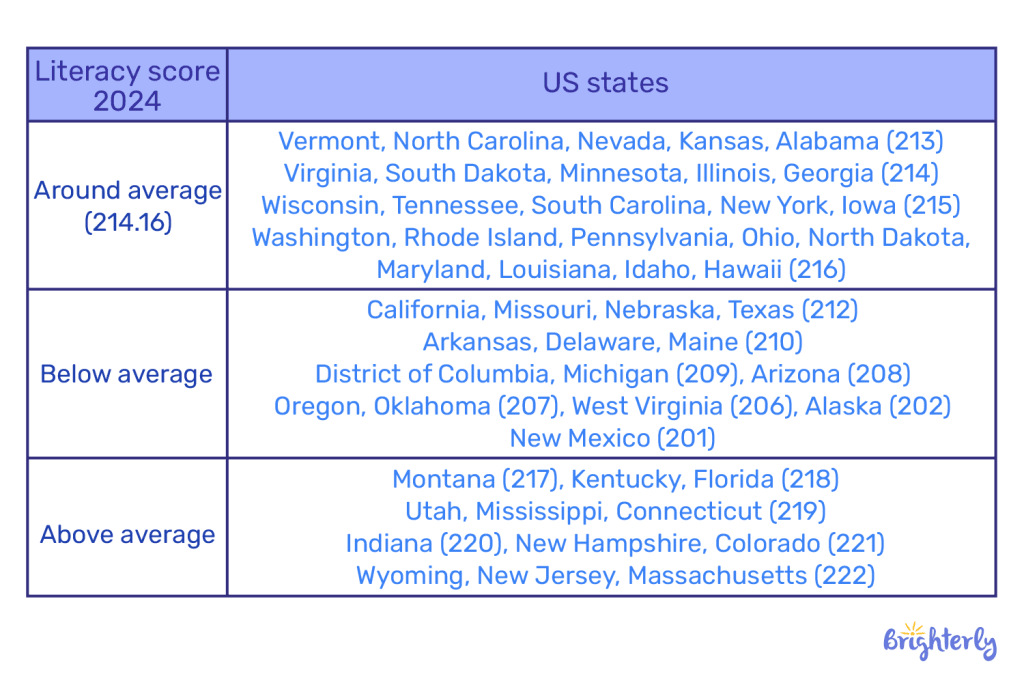
Source: World Population Review, 2024
At the same time, the literacy rate classification here is the point of discussion. For example, the NAEP results in Mississippi showed that 65% of American kids demonstrated reading skills on the raw basic level only.
So, what are some statistics about reading telling us? That the high literacy rate by state can still be a sign of reading skills significantly below the proficiency level in some Gen Z reading statistics.
Note: Based on the World Population Review stats description, literacy rate by state refers to the total number of literate people in a given age group who are able to read and write.
Reading statistics by year
Book reading statistics by year have seen their ups and downs, with the COVID-19 pandemic as a huge disruptor for school reading and a just short-term trigger to read more among adults.
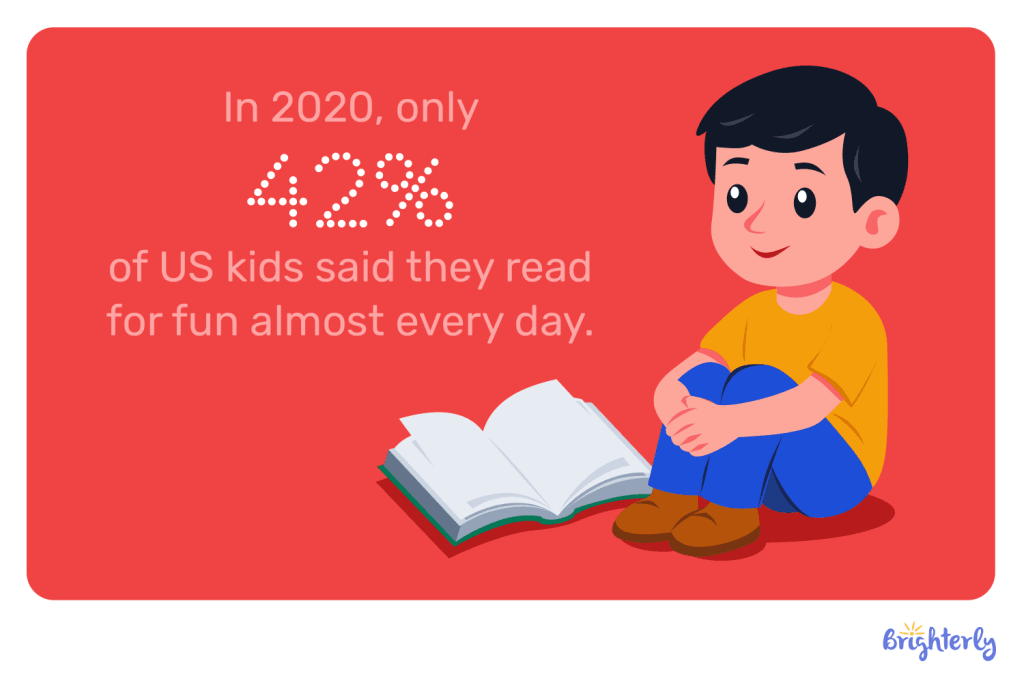
At the same time, 2018-2020 reading statistics for kids were looking more promising, although they already demonstrated rising problems.
Reading Statistics 2018 |
Reading Statistics 2019 |
Reading statistics kids 2020 |
| PISA 2018 results showed a significant 3.7% increase in reading abilities for top-performing students and a great 1.6% increase for the low-performing students (US) | NAEP reading results 2019 slightly dropped compared to 2017 (1 pt for Grade 4 and 3 pts for Grade 8) | The reading for fun trend reached its lowest among 9- and 13-year-old US kids, dropping from 53% to 42% (Per Research Center) |
Although the pandemic could have boosted the popularity of books among US kids and adults, the US reading comprehension statistics between 2022 and 2025 show that it caused a severe drop in test results instead. Also, a lot of Americans still don’t read.
Reading Statistics 2021-2022 |
Reading Statistics 2023 |
Reading Statistics 2024 |
Reading Statistics 2025 |
| 23% of American adults said they didn’t read a book during the past year (Hispanic adults were more likely to say that) (Pew Research Center) | A US Census Bureau survey reported that 48.5% of adults read at least one book in the past year (compared to 37.6% in 2022 and 52.7% in 2018). | NAEP reading results 2024 are -2 pts compared to 2022 and -5 pts compared to 2019. | The numbers remain stagnant, meaning overall declining reading time, low literacy rates, and almost half of the US population reading 1 book or less per year. |
Reading statistics by country
According to the global literacy rate is quite high (86.3%), the country-to-country differences are significant.
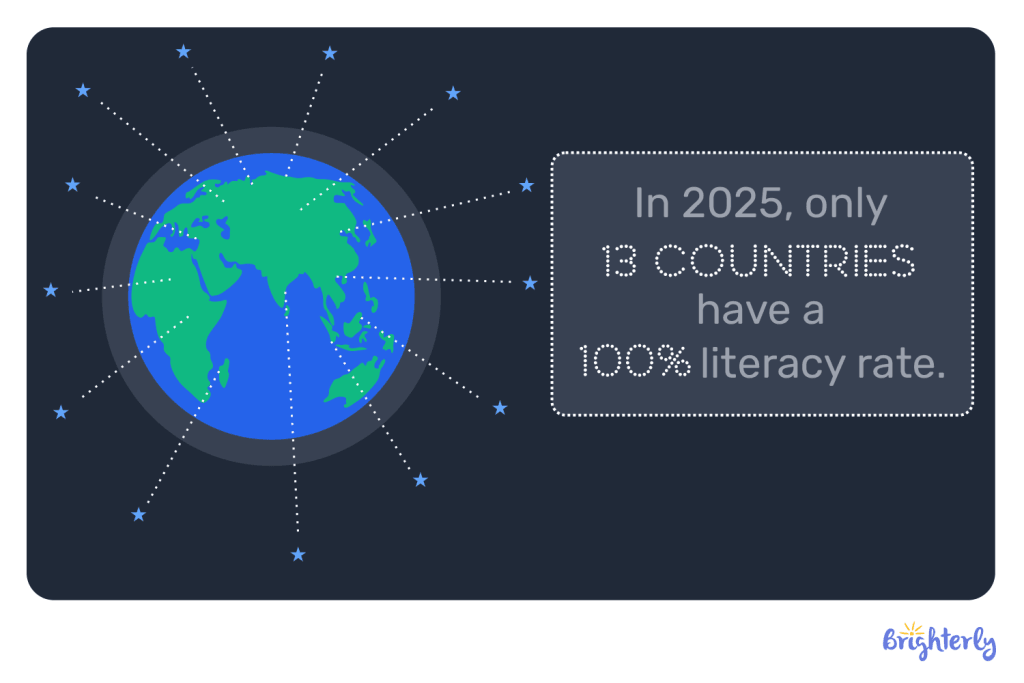
Naturally, developed countries have a higher percentage of people who read books. The ones that boast a 100% population literacy rate are, for instance, Finland, Norway, Georgia, Ukraine, Luxembourg, and Kazakhstan. The lowest 27%- 47% literacy rates are in countries like Chad, Mali, South Sudan, Guinea, and Benin.
On average, how many books does each person in the United States read each year? Based on the World Population Review stats, it’s the top country in the world by this criterion, followed by India, the United Kingdom, and France.
The United States |
17 average books read per year |
India |
16 average books read per year |
The United Kingdom |
15 average books read per year |
France |
14 average books read per year |
Reading statistics by age
The child literacy statistics United States are different from the research findings on all the age groups.
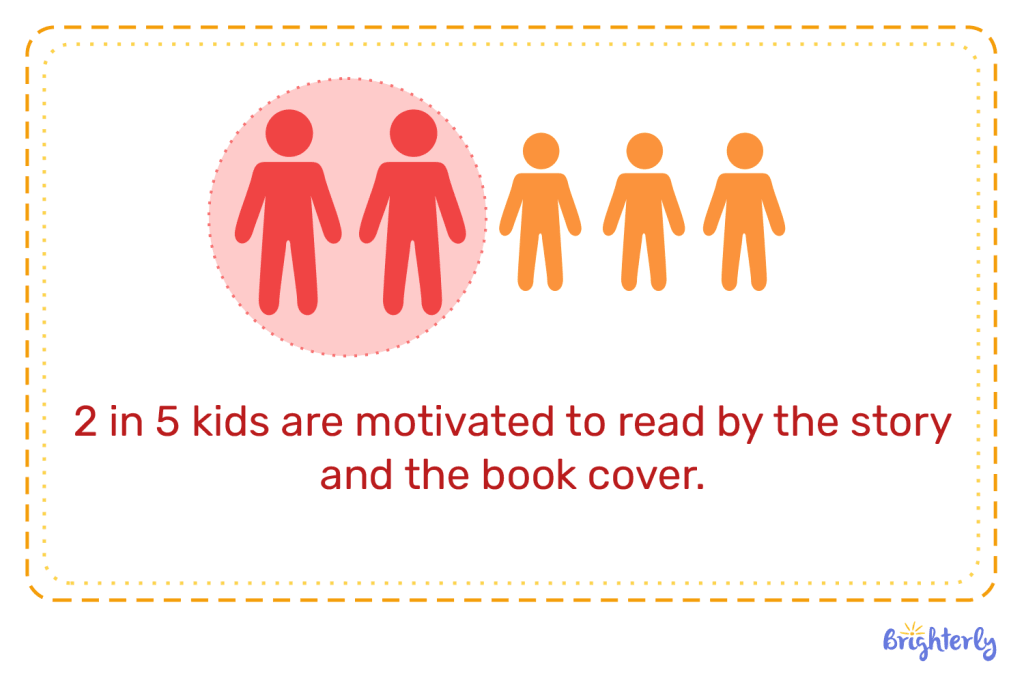
Is reading becoming more popular? While kids mostly need parental and school support to feel love for books, their older generations show a declining interest in books after school or university is over.
K-12 |
Generally struggling with NAEP reading exams and losing motivation to read for fun |
18-24 years old |
81% (compared to 83% in 2019) of respondents read at least one book per year in the US. |
30-49 years old |
72% (compared to 79% in 2019) of respondents read at least one book per year in the US. |
50+ years old |
67-68% (compared to 68%-72% in 2019) of respondents read at least one book per year in the US. |
Sources: Statista, Pew Research, NAEP
Are reading rates declining?
Based on the 2025 statistics, reading popularity is declining. Kids struggle with post-COVID pandemic learning loss, while older generations prefer gadgets to books. Although the global literacy level is very high in most countries, some parts of the world suffer from uneven and gender-biased access to basic education.
10 facts about reading for kids
- Private tutoring helps with reading
- Reading mostly feel relaxing
- Motivations to read are very different
- Parents contribute to reading motivation
- Reading makes people more empathetic
- Reading helps getting better grades
- Health benefits is the reason why people read
- Inventing unusual ways to interest kids in books works
- Reading is a bonding experience
- Reading can help with concentration
Fact #1: Private tutoring helps read better
The article by Stanford reveals that kids who took an early tutoring program achieved better reading fluency than kids who didn’t. Thus, hiring a tutor to help your kid improve reading skills has proven its effectiveness to many parents with struggling kids.
Reading facts for students on private reading tutoring from Brighterly
- Studying starts with a free diagnostic test to identify key areas for improvement
- Lessons are customized to each student to match their temper, goals, and pace
- Learning curriculum is aligned with the Common Core standards
Fact #2: Reading should feel relaxing
Based on the Everand Reading Report 2025, 85% of readers admit that reading brings them calm and helps them relax.
Other reading facts on the positive emotions people find in books
- Permission to spend some time somewhere different
- Giving a way out of life
- Place for safe imagining
- The feeling of lightness
- A chance to live in another place in time
How to apply these statistics on reading to your child
If your child doesn’t like to read, consider recommending them a book when they feel stressed or anxious. This way, you can show them how reading helps bring back the sense of tranquility and control.
Note: If your kid cannot consider reading relaxing because they are worried about their grades at school, get them free reading tests. There, they can practice and get themselves familiar with exam reading tasks.
Fact #3: Kids have different motivations to read
According to National Literacy Trust research, 2 in 5 kids are more motivated to read when the book is related to what they like: a movie or TV show, favorite sports, or their hobbies.
Other motivational factors from these statistics about books
- Book cover: Both children and adults love a bright, catchy cover, and publishers pay attention to this to boost sales in print.
- Freedom to choose: Let your kid decide what they want, even if it’s something serious instead of childhood stories.
How to improve these children reading statistics
Let your kids find books that look and feel more interesting to them. Bring some fun fact about reading to return their engagement and excitement to read.
Fact #4: If parents don’t enjoy reading, neither will their kids
The Guardian states that spending more time on gadgets instead of books contributes to the feeling of a lack of reading enjoyment for parents and their kids.
How it works in practice
- You don’t read much yourself at home
- You get annoyed by the need to repeat paragraphs or read the same books over and over
- You didn’t read to your kid before they turned 5 (only 41% reported doing this).
How can you impact reading to your child statistics
Show your kid love for books by reading together. This way, they learn how to pronounce and memorize new words, better understand what’s written in the text, and can reflect on what they’ve read. Don’t neglect this time together to maintain a higher literacy level and reading skills for your kids.
Note: If you feel you don’t have time or energy to demonstrate your love for reading to your kid, consider enrolling them in the reading program. Tutors and fellow readers there will help them see reading as fun.
Fact #5: Reading improves empathy and emotional awareness
It’s a great reading fact, which means it helps children gain empathy and appreciation for other people’s feelings. Child Mind Institute states that kids read about other people’s lives that are different from their own and realize that big feelings like anger or fear are normal.
Reading about these emotions also helps kids talk about them more easily and understand when others feel the same way.
How to maximize these statistics about reading benefits
Help your kids share whether they’ve felt anything like that before and how they would handle different emotions. Remember that in addition to being educational, reading also helps develop an understanding of how to handle different feelings.
Fact #6: Reading helps get better grades at school
Research states that reading helps kids improve their academic excellence in most subjects, not just English.
The impact of reading on the overall academic performance
- Better imagination and creativity
- Higher concentration
- Extensive vocabulary
- Improved language acquisition
- Better social skills and interaction
How to maximize benefits of reading every day
Find a pleasant and joyful attitude to make a book the best friend for your kid. Don’t make it too serious or put too much pressure, like setting a timer to fill reading 20 minutes a day statistics. Let it flow at their own pace.
Note: If you notice your kid struggles with some reading aspect, get some exercises from these free reading worksheets to quickly help them.
Fact #7: Reading is healthy
Reading has plenty of physical and mental health benefits, developing both cognitive and social skills. Provided your kids read every day, they can greatly improve their well-being.
The most important health benefits of reading
- Better sleep, especially after a session of bedtime reading
- Reduced cognitive decline
- Lower stress level
- Higher intelligence and stronger health literacy
How to make reading 10 minutes a day statistics work
Create a reading schedule for both you and your kid with sufficient time for you to read to them. For younger kids, this will develop a habit and facilitate the learning process in the future (especially if the stories you read are interesting to them).
Fact #8: You need to be creative to maintain their motivation
The National Literacy Trust states that one in three children does not find reading enjoyable, while only 35% of kids aged 9-18 find it a pleasant pastime. Hence, motivating kids in intrinsic and extrinsic ways to read helps.
How to improve reading facts for students by inventing new motivations
- Find books suitable for their age and development level.
- Incorporate interactive elements into reading, like talking about the passage, using dedicated worksheets, or having little quizzes on what they’ve read.
- Reward kids for completing certain minutes of reading with a toy, their favorite candy, or another little gift your kid would love.
- Take your kid to a bookstore or a reading club to meet peers who share a love for the same stories they read.
Fact #9: Reading is one of bonding experiences
While some parents struggle with reading to their kids, others use it as a way to build a stronger connection with their kids.
Reading facts and statistics on reading as bonding
- 81% of parents see enjoying quality time together as one of the benefits of reading
- 68% answered that bonding is one of the key motivations for them to read with their kids
- 75% of parents wish they had more time to read with their children.
Fact #10: Reading helps minimize issues with focus and attention
With the decreasing attention span among both kids and adults, reading can help regain focus and make ADHD more manageable.
How to apply this fact about reading
- Dedicate some time to just reading: no gadget notifications, toys, or extra activities.
- Try the Pomodoro technique not to miss the time for rest.
- Start gently and gradually increase the intervals for better results in the future.
Child literacy statistics in the United States: Final verdict
Given all the factors described above, it is no surprise that your kid struggles with reading or doesn’t like books. But there are several ways you can work on these problems, ranging from buying books with better covers to setting short reading sessions with enough breaks in between not to overwhelm your child.
In this list of possible measures, private reading tutoring is one of the quickest and easiest fixes for busy parents. All you need to do is book free lesson and see how it works!




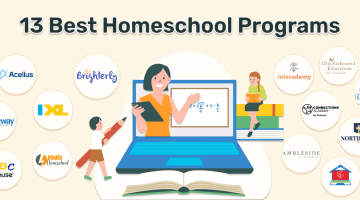

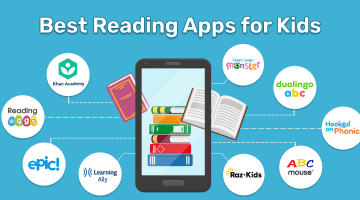



![Cuemath Reviews: All You Need to Know [2025]](https://brighterly-stage.xyz/wp-content/uploads/2025/07/Cuemath-Reviews_-All-You-Need-to-Know-e1754582226241-360x200.png)



